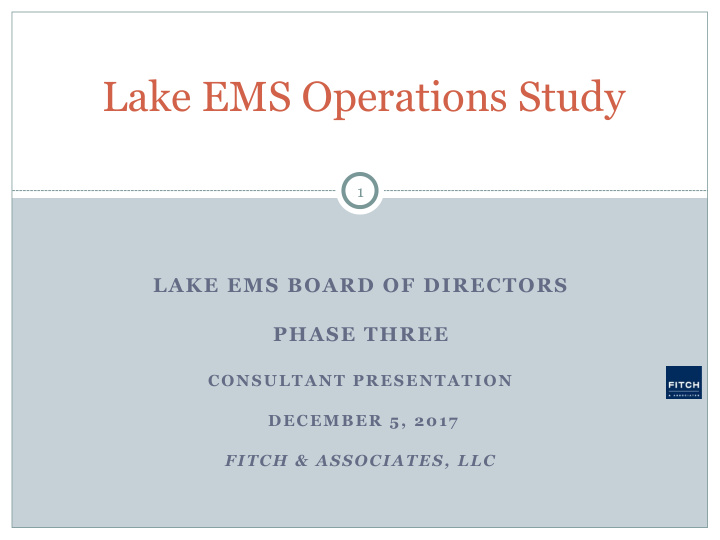



Lake EMS Operations Study 1 LAKE EMS BOARD OF DIRECTORS PHASE THREE CONSULTANT PRESENTATION DECEMBER 5, 2017 FITCH & ASSOCIATES, LLC
EMS System Design 2
Responses by Agency 3
Cost Comparisons 4
Phase 1 - Deployment Costs for Implementation 5 ● Adjust one 0900-2200 to 0800-2100 ● Adjust one 0900-2200 to 0700-2000 ● Add 0700-1900 on Friday ● Add 1900-0700 on Friday ● Remove 0900-2200 on Sunday ● Additional 11-hours per week at a UHC of $113.37 is $64,848 annually.
6
7
EMS Response Time Improvement 8
Implementation Considerations - Lake EMS 9
Projected Growth 10
Workload Considerations 11
Workload Management Strategies 12 ● The 24/48 hour shift is the most fiscally efficient manner to staff for 24 hours ● Lake EMS has maximized this most efficient deployment for many years ● Workload is too high for five of the 24-hour units ● Given the total time on task of 43,705 out of the 161,330 deployed hours the fleet could remain below 0.30, at 0.27 if the workload was managed and evenly distributed ● Once the workload is greater than the ability to manage, it is suggested that units are incrementally changed to 12-hour shifts. ● Each 24-hour unit converted to two 12-hour shifts would cost an additional $149,575.
Analysis of System Fragmentation 13
Analysis of System Fragmentation 14
Implementation Considerations - Lake EMS 15 ● Utilize the report’s urban/rural analyses to define urban/rural areas that correlate to the dispatch response parameters ● Design response areas for the Lake County Fire Rescue rural transport units ● Ensure LCFR units have MDT’s and AVL capability in the identified rural transport areas ● Utilize AVL to determine closest responding units for both the urban/suburban and rural areas separately ● Allow the MPDS process to complete the call triaging prior to dispatch ● Identify the closest existing stations to the optimized posts and their suitability for accommodating Lake EMS crews ● Develop the ISBA areas in the new CAD with different response parameters for emergent versus non-emergent calls ● Obtain a blanket or master automatic-aid agreement and remove emergent response activity from the ISBAs. ● Ensure that all units and fire departments have MDTs and AVL capabilities ● 18 Month to 24 Month Implementation
Medical Priority Dispatching 16
Summary of Recommendations 17 ● Lake EMS to change deployment plan that maintains current urban performance and improves rural performance ● Cost of approximately $65,000 ● LCFR to provide cross-staffed ambulance services in 6 to 8 rural stations ● No additional recurring costs ● Evaluate workload and adjust accordingly at approximately $150,000 per 24 to 12 hour conversion ● Remove “emergent” incidents from the ISBA boundaries and utilize a master automatic-aid agreement countywide
Summary of Recommendations 18 ● Under current deployment, optimized staffing for Lake EMS would be 136 personnel assigned to ambulance services ● Lake EMS currently has 131 ● This 5 person gap will significantly influence OT ● Fleet should maintain 140% of peak ambulance deployment ● This would be approximately 10 units in reserve ● May need additional units to account for remount lag time
Questions? 19
Recommend
More recommend